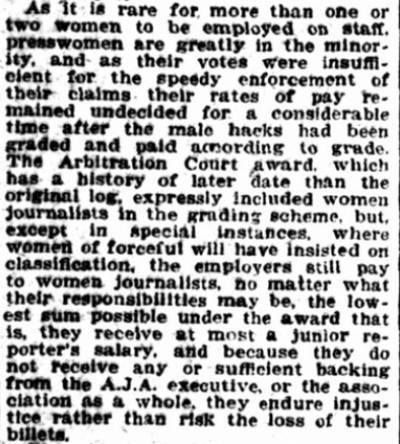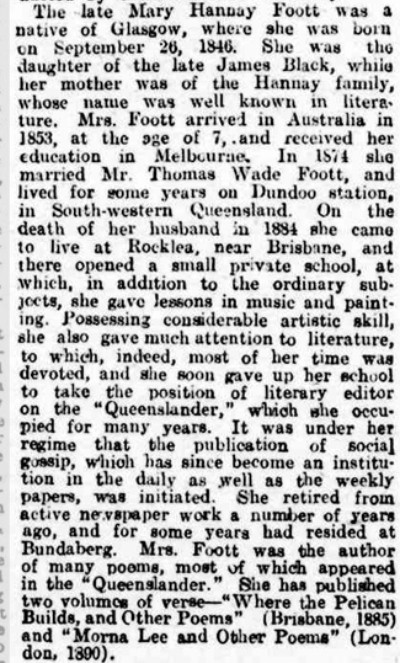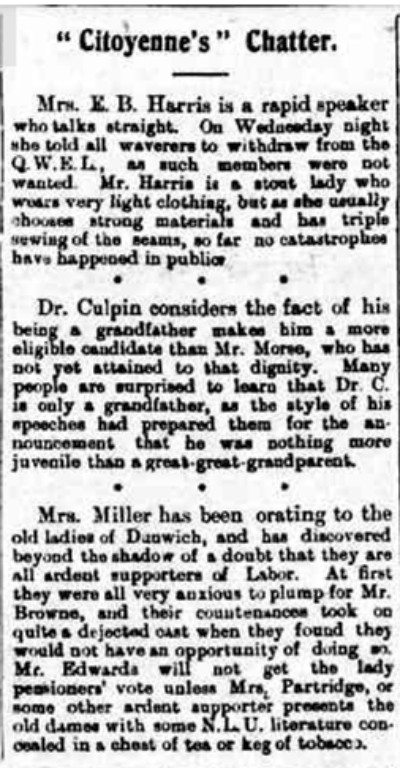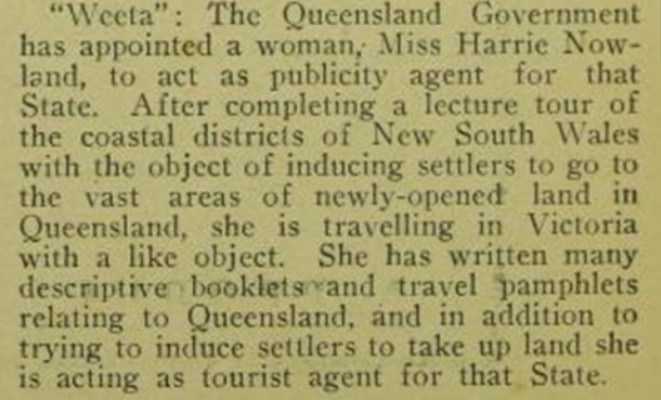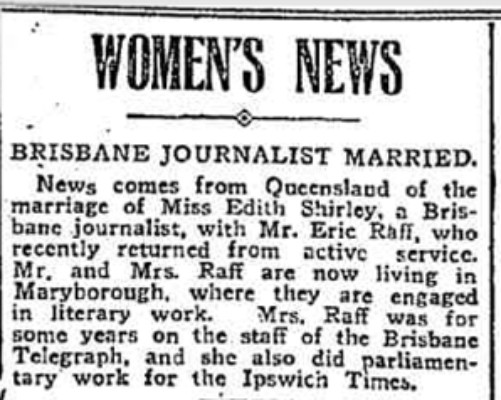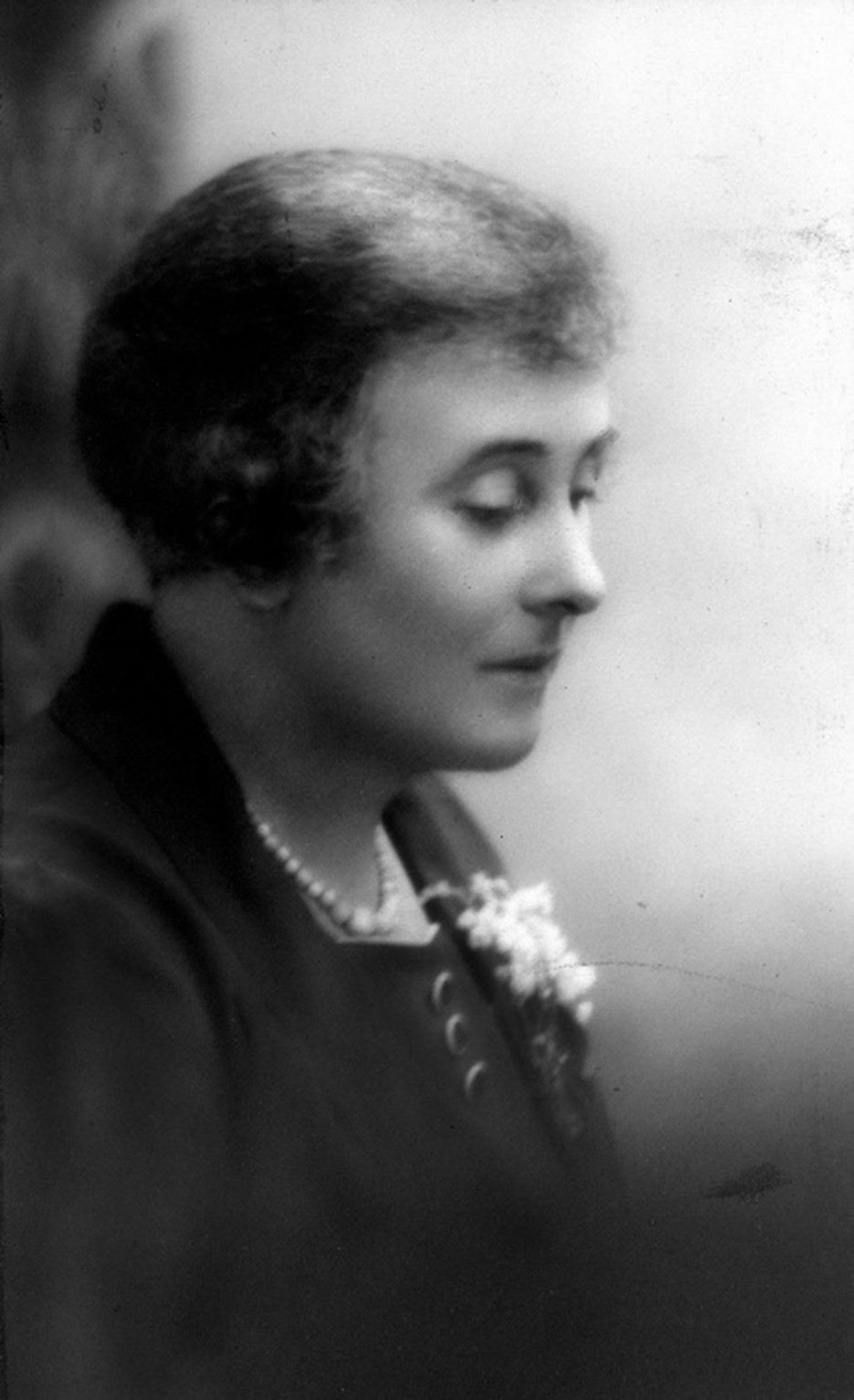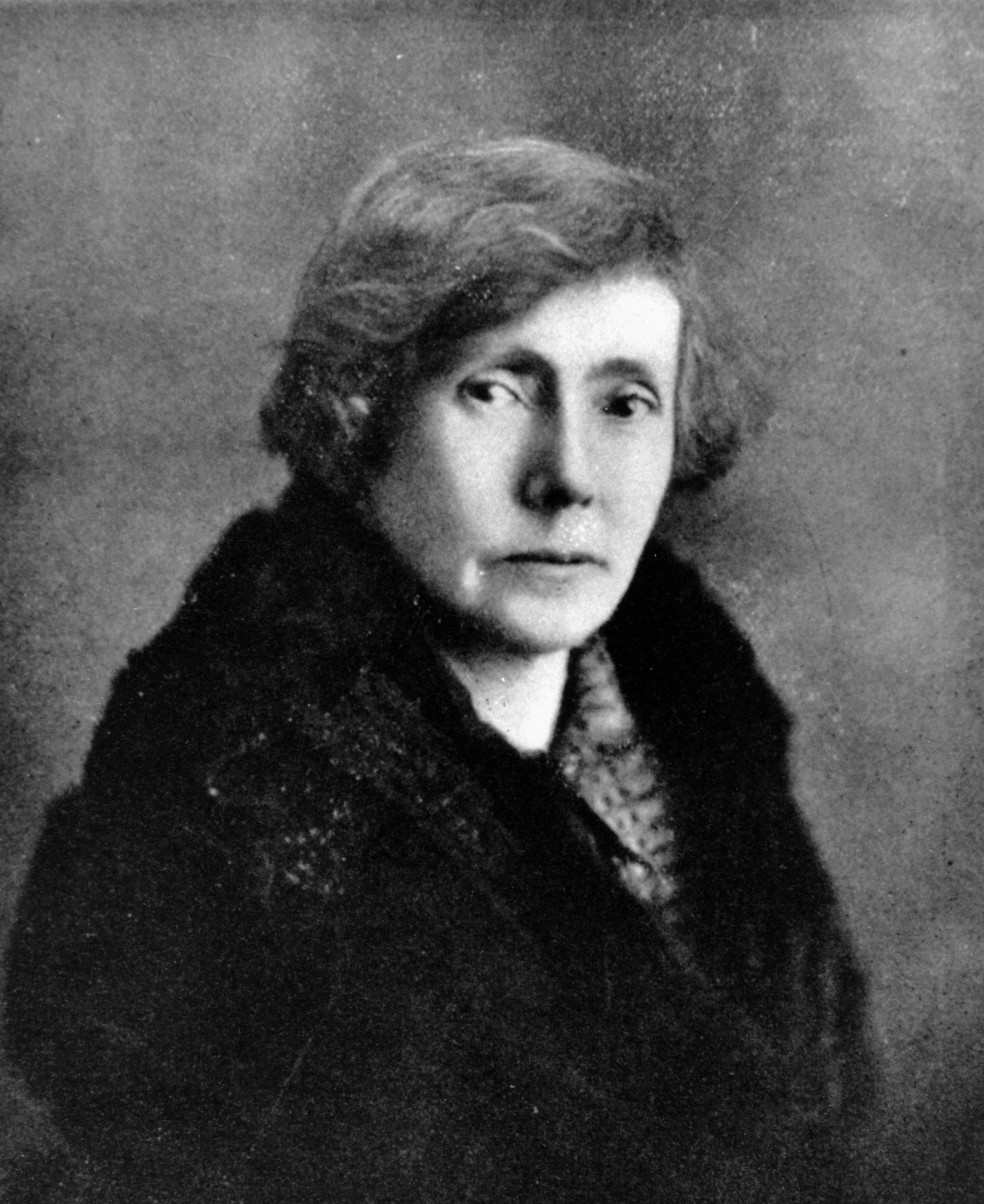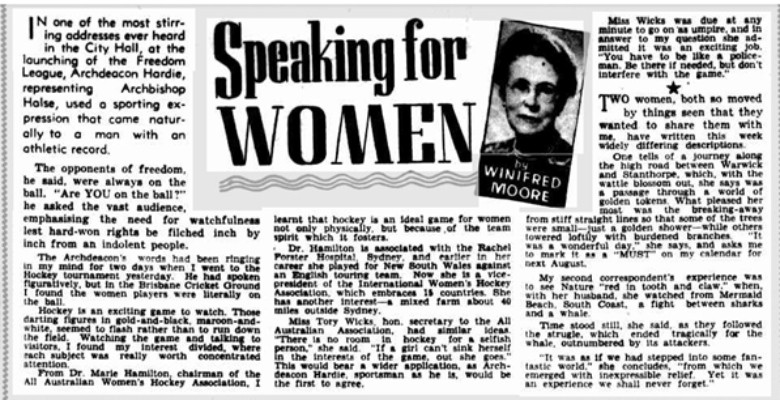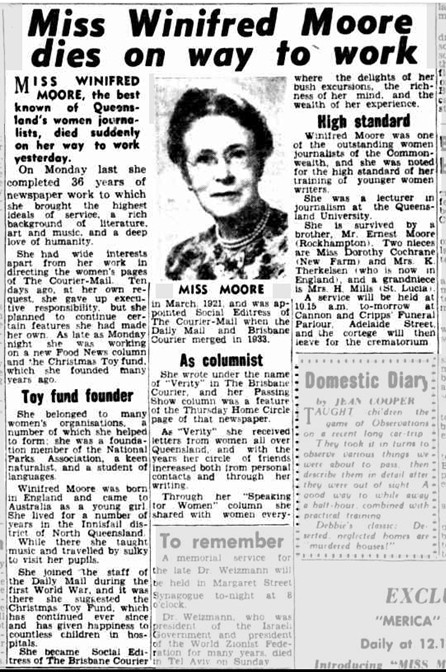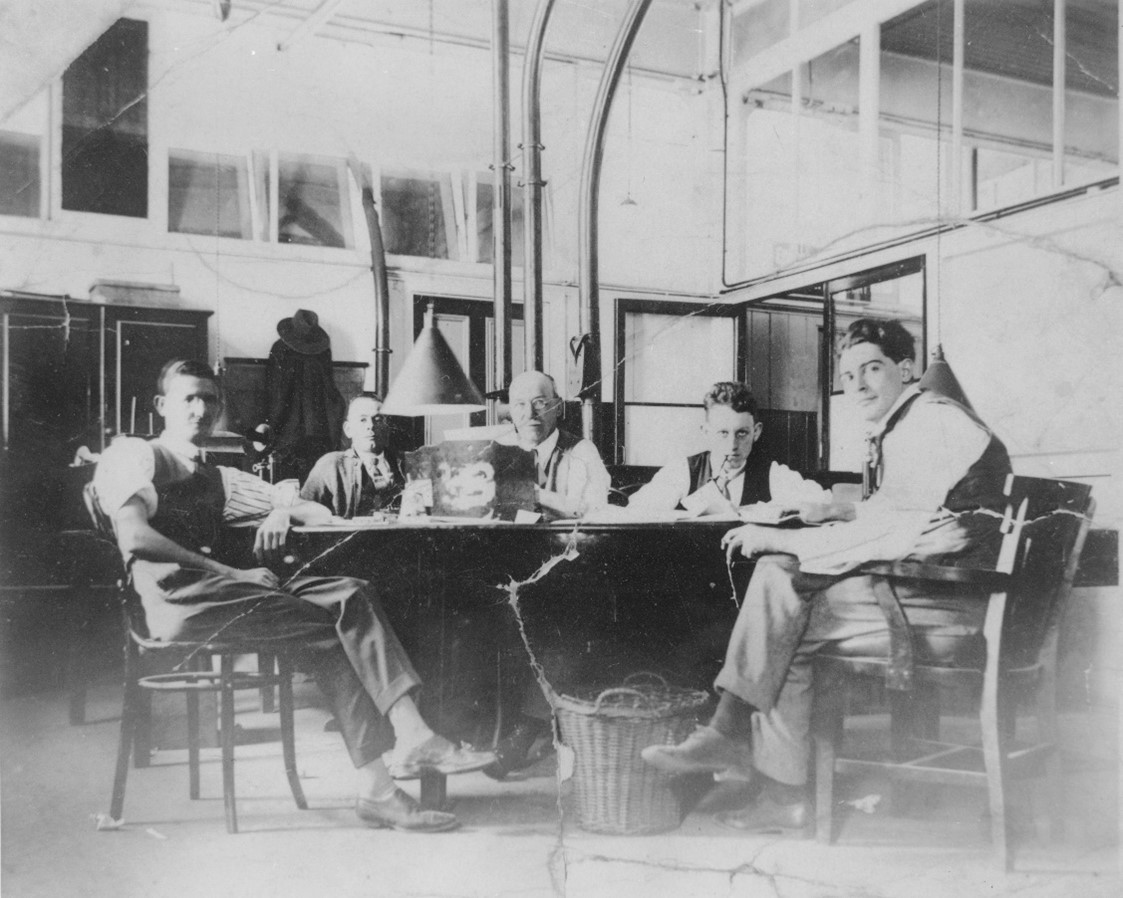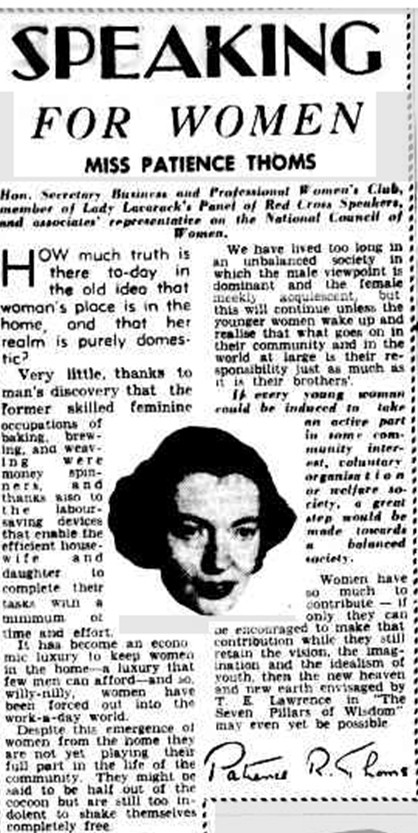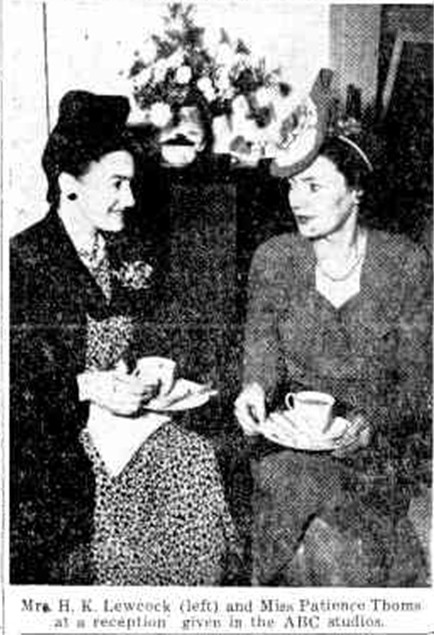Queensland women in the media: women journalists of the 20th century
By Christina Ealing-Godbold, Research Librarian, Information and Client Services | 4 March 2024
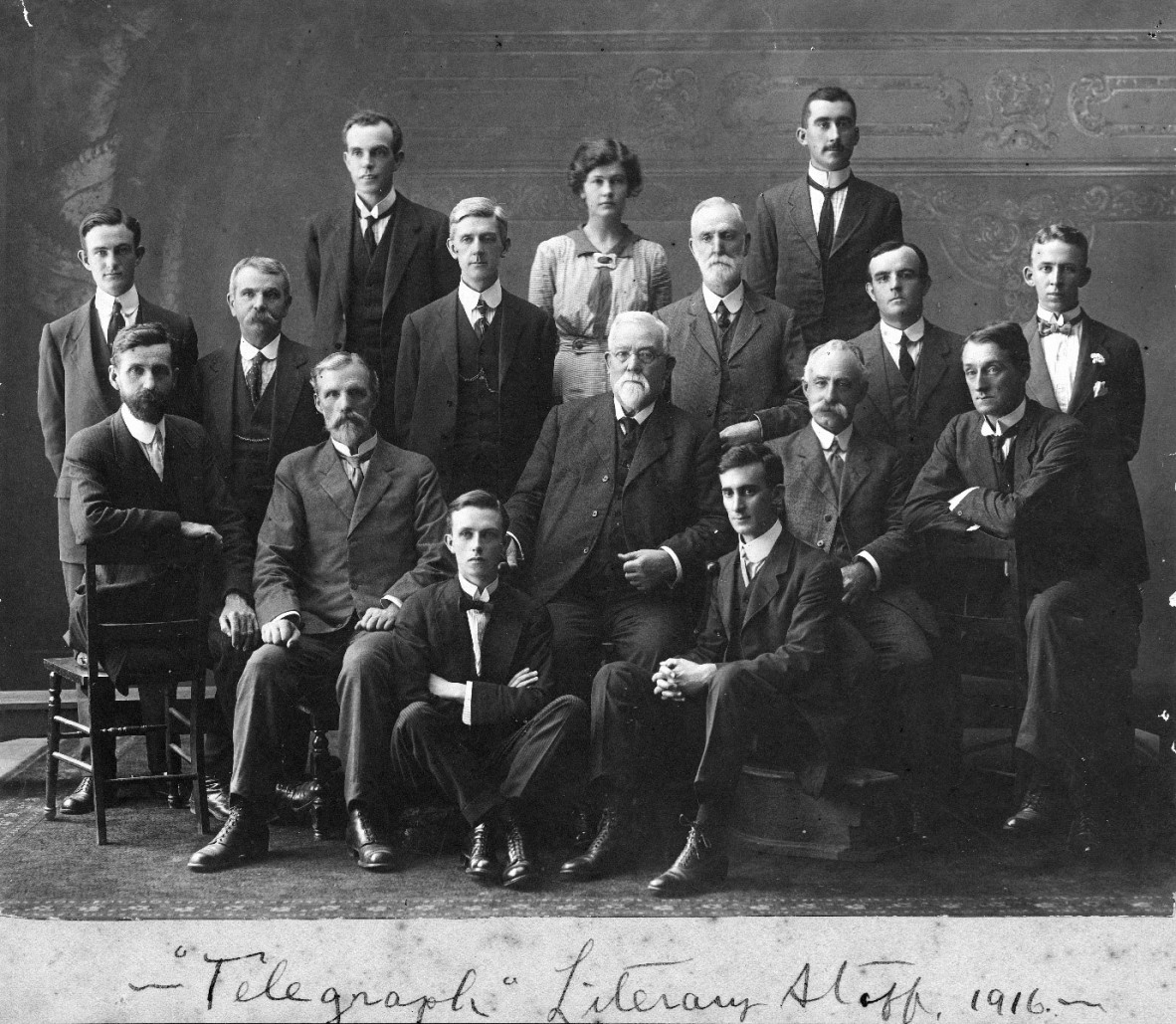
Telegraph's Literary Staff, Brisbane, 1916, Miss Edith Shirley and the staff of the Telegraph Literary Department. John Oxley Library, State Library of Queensland, Negative number: 203543
Women journalists, often referred to as presswomen, were employed on Brisbane newspapers from the end of the nineteenth century. On International Women’s Day, it is important to reflect on how women found their voice and had their opinions published in Brisbane newspapers. The journalists listed in this blog are not the only female journalists who worked throughout the twentieth century. However, they are the working female journalists who were best known as presswomen in Brisbane.
The skills of women journalists were primarily confined to the women's interest pages throughout the century. Even regional newspapers had women’s pages, although authorship was usually not attributed to any one woman journalist. Patricia Clarke, in Bold types: How Australia’s First Women Journalists Blazed a Trail, noted “Most Women journalists worked on the women’s pages of newspapers. They were usually paid at the lowest level” (Clarke, p1.) Lord Northcliffe, British Press Baron, noted in 1912 that:
The coming of the woman writer in her hundreds has brought the woman reader in her millions; and the coming of the woman reader has developed the advertiser, upon whom all of us journalists, however lofty we may think ourselves, depend for our existence. (Australian Journalist, 21 Feb 1913, p17-18).
However, the women’s pages changed in content throughout the twentieth century, becoming increasingly broader in topics and tone, and in some cases, the pages were used to educate women with regard to opportunities and possibilities in their lives. Some journalists were able to work within these parameters, while others could not stand the limitations of weddings, social events and household management and left to work in other spheres. Research into the work of women journalists is challenging because many wrote under “Nom de Plumes” and often used several when having material published in different newspapers and magazines. Women contributed literary material (poems and short stories) to a number of publications, including newspapers and magazines.
In 1915, the activities of the Australian Journalists Association (which had by this time established a Queensland branch) were highlighted by a letter in the Brisbane Courier, where it is stated that presswomen were greatly in the minority and only one or two women were usually employed on the staff of any one newspaper.
However, some women persisted in their chosen profession of journalism, despite being poorly paid compared with their male colleagues, and despite being in the minority.
Mary Hannay Foott
The first woman journalist in Brisbane was Mary Hannay Foott, who was the editor of the women’s pages in The Queenslander from 1886. Her pen name was "La Quenouille" and her column in the early days was called "The Housekeeper". Mary had an office in the new Courier Building in Queen Street and was not only the editor of the women’s pages in The Queenslander, but also wrote many stories, poems and answers to correspondence and was best known for her poem "Where the Pelican Builds Her Nest". Mary Hannay Foott died in 1918.
Harriett (Harrie) Nowland
Harriett Nowland, known as Harrie, was an example of a female journalist who refused to be confined to women’s social activities and home issues.
In Brisbane, The Daily Standard was the newspaper that appeared to employ women journalists as early as 1903. Harrie Nowland wrote for the Daily Standard, The Truth and the Brisbane Courier. She broke away from the tradition of writing for women and children, contributing to political journalism about issues of the day.
By her own admission, Harrie declared that she had lived in the three eastern states of Australia and travelled extensively in the other Australian states. Harrie wrote in various publications that she was a senior journalist with extensive experience. Journalism degrees were not usual at Australian universities prior to 1928, and journalists completed grading on the job.
Harrie Nowland appeared in Brisbane around 1903, and began working as a journalist almost immediately. Unlike other female journalists, she listed herself as a journalist on the electoral rolls of the day. Other women literary contributors and journalists often did not – simply listing their occupation as “home duties”.
Harrie was possibly born in Muswellbrook, New South Wales, in 1867/1868, her parents being James and Mary Nowland. Her sister, Mary Ellen, married James Benjamin Sharpe (of Sydney) in 1892 and thence the couple made their way to live in Brisbane. James Benjamin Sharpe established the newspaper, The Daily Standard. He was well known and well connected in early twentieth century Brisbane.
Harrie wrote under the pen name “Citoyenne” and later, “La Parenne”. She wrote about both men's and women’s issues and, during the First World War, expressed views on conscription and government policy. “Citoyenne’s Chatter" began in the The Truth in 1903 and was posted on page 1, most unusual for the contribution of a woman journalist.
Harrie Nowland claims to have been the first female parliamentary reporter in Australia, sitting in the press gallery in Parliament House in Brisbane. Another Queensland journalist, Edith Shirley, reported on parliament for the Telegraph and the Ipswich Times up until 1919. Other journalists have put Stella Henderson as the first Parliamentary Reporter (not in Queensland), but numbers 2 and 3 are Harrie Nowland and Edith Shirley, both from Queensland – indicating a progressive journalistic environment in the state of Queensland.
After working as a newspaper journalist, Harrie worked for the Queensland Government, drawing attention to land and tourism. She published books on Queensland Railways and Australian tourism. During the 1920s, she delivered lectures about Queensland and also about America and prohibition. Harrie travelled to America at the request of the Australian Government, took up journalist jobs in various cities and reported on the state of the United States to Australian audiences. In the early 1930s, as a freelance journalist, Harrie Nowland wrote articles about the plight of women in sweat shop employment, as underpaid employees and vulnerable women struggling to survive. She died in 1949 and is buried in the Toowoomba cemetery.
Edith Shirley
Edith Shirley worked for the Telegraph during the World War One era and was known to have also been a reporter in the Parliamentary Press Gallery in Queensland. She retired to marry in 1919, authoring the Australia Jane’s Annual later in that year.
Alice Gore-Jones
During the 1920s, Alice Gore-Jones also wrote for The Telegraph and was a representative for women for the Australian Journalist Association. She was also on the Council of the Press Institute in Brisbane. Alice was a poet, well known for her published works. In the newspaper she wrote about the architecture of old Queensland houses, about opportunities for women in the university system and other diverse subjects. Born in Toowong in Brisbane in 1887, Alice died in 1961. Other Telegraph female staff were Edith Shirley (retired in 1919) and Mavis McMaster who retired in 1936.
Alice Guerin Crist
Alice Guerin Crist directed her journalism towards the Catholic press. Also a poet, with several books of published poetry in the 1920s, she contributed to the Brisbane Catholic Advocate, The Australian Worker and The Toowoomba Chronicle. In 1930 Alice became "Betty Bluegum", editor of the children’s page of the Catholic Advocate.
Winifred Moore
Winifred Moore joined the staff of the Daily Mail during the First World War. During her career of more than 35 years as a journalist, Winifred, an English woman by birth, delivered her column called “Speaking for Women” in the Courier Mail.
Winifred worked on the weekly women’s section of the Brisbane Courier through the 1920s and combined information on Paris fashion, home circle information, novels and news of Australians aboard, as well as how to knit slippers and make clothes. In earlier years, she wrote under the pseudonym of Verity.
Winifred, a trained musician and music teacher in her younger years, became the women's pages editress at the merge of the Brisbane Courier and the Daily Mail in 1933, and was assisted by a staff of 5 by 1946. She was a lecturer in journalism at the University of Queensland, and established the Courier Mail Christmas Toy Fund, which continued for generations.
Winifred had a wide range of interests in the community, including as a founding member of the National Parks Association. She used her own column to discuss questions about women in parliament, women and marriage, and women’s organisations. Patience Thoms, the journalist who took over from her, acknowledged her predecessor as a journalist who “wrote as a woman, not a feminist but as one conscious of the contribution women could make if they had the will” (Patience Thoms. Media Hall of Fame.) Winifred Moore died on her way to work at the Courier Mail in 1952.
Patience Thoms
Patience Rosemary Thoms, born in New South Wales in 1915, became Women’s News Editor of the Courier Mail in 1956. Having begun her journalistic career in 1945 with Queensland Country Life, Patience moved across to the Brisbane Courier and took over the editress role from Winifred Moore. A respected journalist, Patience prepared the women’s pages with social gatherings, weddings and information on household matters, everything from kitchen design to recipes. Her articles also promoted concerns for Queensland women, such as better accommodation for female teachers, automatic telephone systems for country women and opportunities for young women in employment and education. She was President of the Australian Federation of Business and Professional Women’s Clubs (1960-1964) and President of the International Federation of Business and Professional Women (1968-1971) (the first Australian to hold this office).
As women’s editor, Patience had to fight for the right to attend the 5pm daily news conferences with male journalists at the Courier Mail, and also fought for a woman to sub-edit the women’s pages. Sub-editors had always been male up until this point.
Patience worked hard to publicise the opinions of women in Brisbane through her pages. She phoned many Brisbane women to ask questions about their opinions and even how they intended to vote in upcoming elections. These surveys were then written up in the women’s pages. Patience did not want her column to be simply about domestic issues, and often referred to the educative role of the women’s pages later in the twentieth century.
Always interested in languages, Patience began a second career as a mature age student in 1976, studying for her Bachelor of Arts in the School of Modern Asian Studies at Griffith University. She continued to work for the university after graduating in 1980, and was a member of the University Council from 1980 to 1994 and Deputy Chancellor from 1988 to 1992. She was also a member of the Queensland Film Board of Review (1974-1985), member of the Ethics Committee of the Australian Journalists’ Association, a member of the National Drug Advisory Council and a member of the Council of Queensland Women. Patience Thoms was admitted to the Australian Media Hall of Fame. She passed away in Brisbane in 2006.
Throughout the state, regional newspapers followed the example of the metropolitan papers and included women’s pages in their publications. However, the position of Social Editress and its importance gradually faded, and news is now presented for both men and women. Mary Hannay Foott and Patience Thoms were the Social Editresses at the beginning and end of this media trend in Brisbane newspapers.
Further Reading
Women journalists in Australia
- Australian Women Journalists and the “Pretence of Equality”/Jeannine Baker
- Bold types : how Australia's first women journalists blazed a trail / Patricia Clarke
- Pen portraits : women writers and journalists in nineteenth century Australia / Patricia Clarke
- “Those Knights of the Pen and Pencil”: Women Journalists and Cultural Leadership of the Women's Movement in Australia and the United States/ Diane Kirby
- Australian Women’s Register
Publications from the women journalists of Brisbane
Mary Hannay Foott
- Mary Hannay Foott Papers 1881
- Morna Lee and other poems / Mary Hannay Foott
- Where the pelican builds and other poems / Mary Hannay Foott
Harrie Nowland
- Commonwealth of Australia. Department of External Affairs. Miss Harrie Nowland File of Papers. Articles by Miss Nowland.
- The Queensland Government has appointed a woman, Miss Harrie Nowland
Alice Guerin Crist
- Eucharist lilies, and other verses / Alice Guerin Crist
- Go it! Brothers!! / Alice Guerin Crist
- When Rody came to Ironbark, and other verses / Alice Guerin Crist
Alice Gore-Jones
Patience Thoms
- Australia Media Hall of Fame
- The first 25 years, B.P.W. Australia : the history of the Australian Federation of Business and Professional Women's Clubs / compiled from official records/ Patience R. Thoms
More information
One Search catalogue – https://onesearch.slq.qld.gov.auopen_in_new
Library membership – https://www.slq.qld.gov.au/services/membership
Ask a librarian - https://www.slq.qld.gov.au/services/ask-librarian
Plan your visit – https://www.slq.qld.gov.au/visit
Comments
Your email address will not be published.
We welcome relevant, respectful comments.
